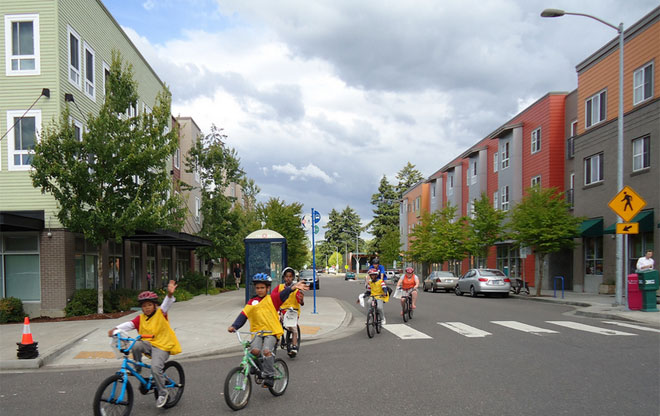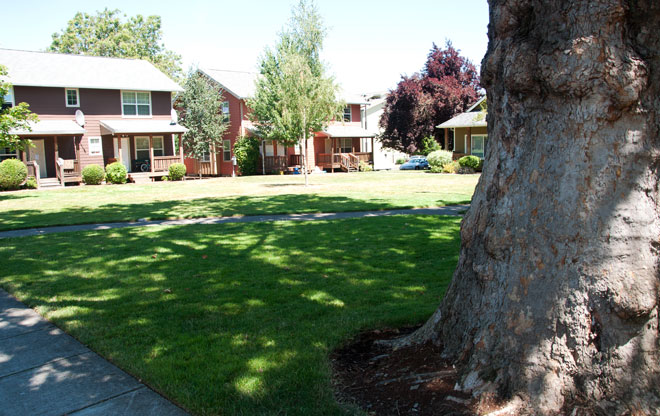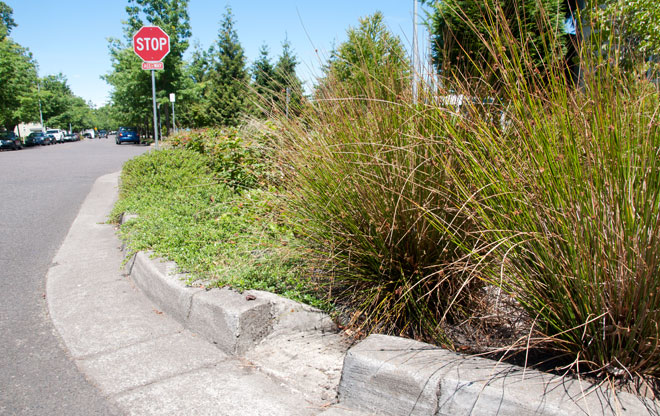
A Walkable and Bikeable Community
New Columbia won the 2007 Smart Growth Achievement Award in overall excellence. Streets have been laid out in a grid pattern that connects to the surrounding community, with pedestrian paths bisecting the longer blocks. Pedestrians and cyclists were given priority. Streets are narrow to slow traffic and bring the community together, whether on foot or by bicycle. Secure, indoor bicycle storage is provided for residents.
Image: Community Cycling Center 
The Core of New Columbia
McCoy Park, New Columbia's four-acre central park, is the core of development. It was named after Bill and Gladys McCoy, African-American political leaders who brought attention to the issues of minority and low-income people in north Portland. The park, designed by Murase Associates, is based around a central plaza with a covered gathering space flanked by playing fields, a playground, a community garden, and basketball courts.
Image: Rachel Hill 
Water Play
The water feature at McCoy Park spurts and jumps in seemingly random patterns while children of all ages run through it. Some are caught off guard, soaking their sneakers. Others come ready in bathing suits while their parents sit on blankets under a tree. With no standing water, there is no need for a lifeguard and no fear of drowning. Few resources are required for such a well-used and appreciated amenity.
Image: Rachel Hill 
Neighborhood Amenities
Shady trees, a simple plaza, and a playground form the center of McCoy Park. An informal camp is held in the summer here, free of charge, for neighborhood kids.
Image: Rachel Hill 
Community Garden
A community garden is a key part of McCoy Park’s public space. Well-maintained plots are farmed by residents who can now grow healthy food for their families or even sell their produce. Artful metalwork on the garden gates are cut with phrases in different languages.
Image: Rachel Hill 
Commercial Hub
A village market and café across from McCoy Park offers healthy food options. This small commercial core includes a transit stop, apartment buildings, and a “bike skills park.” Similar to other Portland neighborhood centers, it provides for day-to-day needs and is a node of urban life within the neighborhood.
Image: Rachel Hill 
Part Pocket Park, Part Shared Front Yard
Often public housing is conceived as dense, apartment style-living. The single-family home is often out of reach for the economically disadvantaged. Here, tighter housing configurations maintain the urban density while shared, consolidated open space allows for play, gathering, or simply fulfilling the desire for a more suburban residential experience. As part of a “menu” of open spaces, this innovative space is part pocket park, part shared front yard.
Image: Rachel Hill .jpg)
Winding Seat Walls
New Columbia was not a tabula rasa. There are high, rolling hills. Many large, old trees including Bigleaf Maples (Acer macrophyllum) with their wide, knobby trunks and dense shade were preserved. They became central features within the park, as concrete seat walls were designed to wind under their canopies.
Image: Rachel Hill 
Sustainable Stormwater Management
Sustainable solutions reduce pressure on city infrastructure and save money. More than 100 pocket swales and 30 flow-through planters alleviate stormwater needs so dramatically that New Columbia requires 80 percent less underground stormwater piping than a comparable development. The development’s sustainable stormwater-management system retains and infiltrates 98 percent of stormwater on site. They also teach residents about the larger environmental systems of which they are a part.
Image: Rachel Hill